Many septic system installers and other industry professionals recommend capping the inlet Tee to the septic tank if septic odor is a problem at a property. Sometimes the building vent stack (aka stink pipe) is too short to allow smelly septic gases to be drafted away by the wind. Particular wind conditions can cause down drafts that push the vented gasses down over the eaves, where they can be detected by people, rather than dispersing them into the atmosphere.
Common solutions to septic odor problems
Various remedies are typically proposed to address such odor problems. Sometimes it is just a matter of extending the vent pipe. The vent pipe could be fitted with a carbon vent filter although this requires ongoing maintenance and cost to change out the carbon. Alternatively, or when these measures don’t work, it is often suggested to cap the normally open-topped inlet Tee or replace it with a 90 degree elbow. This prevents the tank from venting back through the building plumbing and out the roof vent stack. However, this simple fix has pros and cons which should be considered.
Trapping gasses can cause safety issues, deterioration of concrete
Capping the inlet Tee traps the gasses in the tank which can cause strong odors primarily from hydrogen sulfide gas (H2S) when an access riser lid is removed. It may also lead to increased formation of H2S. If access risers are not air-tight, gases could still be detectable at ground level around the tank.
According to Terry Bounds, P.E., of Orenco Systems Inc., capping the inlet Tee can cause problems in the US with respect to conformity with UL and electrical listing regulations for septic systems with pumps.
The National Fire Protection Association (NFPA) 820 regulation on electrical listings for pressure sewers and individual residential pumping units was revised after a two year investigation into the need for explosion proof and intrinsically safe electric controls in septic tanks. The NFPA changed from requiring Class 1 Division I, explosion proof pumps and intrinsically safe electric controls to classifying residential septic tanks as nonhazardous with respect to methane and hydrogen sulfide gas accumulation. As a result, the NFPA regulations allow “general wiring and non-explosion proof pumps” in single family septic applications and applications with up to 5 homes connected to a single pumping unit. According to Bounds, one of the main reasons the regulations were relaxed is because it was recognized that building sewer vents drafted and exhausted the potentially explosive gasses from the tank through the septic tank inlet Tee.
Examination of septic tank with 90 degree elbow at inlet
The surface of the concrete around the opening was covered with a layer of rusty orange “fluffy” to gelatinous material. Underneath the rusty-orange layer was a black layer, although there may also have been some black material visible two years prior when the risers were retrofit. Could this rusty orange and/or black material be indicative of sulfide attack on the concrete?
You can see from the photos of the tank retrofit above that the soil in PEI is reddish brown due to its high iron content. You can also see that there was some soil on the lip of the tank access opening when the photos were taken. It is likely that soil remained after the retrofit was complete, and so possibly the red-brown iron in the soil has colored the fluffy gelatinous layer making it rusty orange.
Let me know what you think in the comments below.
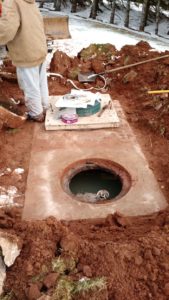
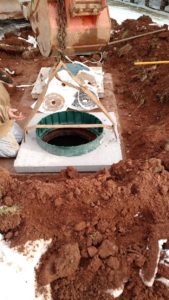
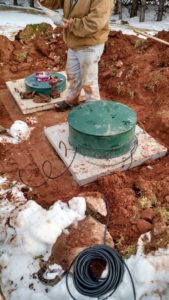
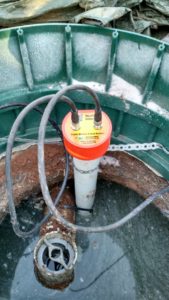
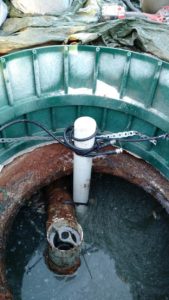

2 Comments